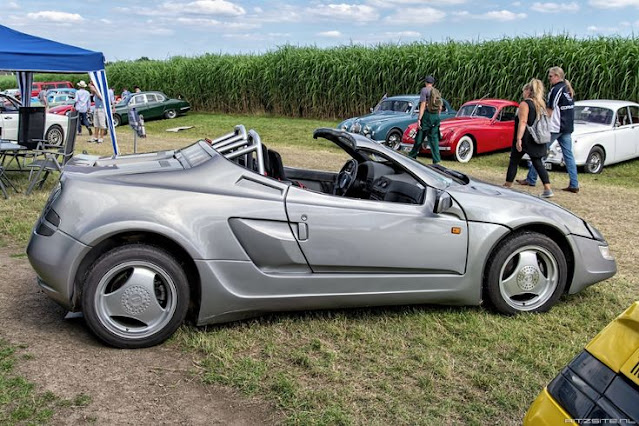Walter Treser is probably best known for his role in the development of the original Audi Quattro or "UR-Quattro", as it is called these days. Treser championed the integration of 4-wheel drive into the company's racing cars and passenger cars. His efforts at Audi resulted in a series of rally racing and DTM competition victories that would continue long past Treser's involvement.
After parting ways with Audi, Treser would found his own tuning and custom car manufacturing company in Hofstetten, Germany. This venture would lead to another relatively well known creation, the "Treser-Audi Quattro Roadster". Making its debut at the 1983 IAA in Frankfurt, the Roadster featured a powered retractable roof and exaggerated, blistered fenders set on a wider track than the stock article. The company also produced a variety of other Audi models with integrated 4wd and raised ground clearances. Sort of the "Safari" thing decades before that was trendy. Among the models of this type was a stretched and lifted Audi 5000.
 |
| A scale styling model of the "Youth Car" |
Still, Walter Treser's true ambition was to create a car of his own. His design brief referred to this as "the Youth Car". It would be compact, without appearing "small". The spec called for light weight and an aerodynamic shape, with a fully retractable folding roof. He thought of it as a "Ferrari for young people", cheeky design, interesting but not too expensive technology, and affordable production costs. "I didn't want a second Karmann Ghia," says Walter Treser, "it's a pretty and successful car, but it remained a VW with a nice special body". The car would come to be called the "T-1".
In retrospect, Treser's statements regarding the Karmann Ghia seem ironic, since his T-1 uses Volkswagen sourced drivetrain components in a "nice special body". The car would use the 1.8 litre 16-valve engine from the Golf GTI, transversely mounted mid-rear, driving the rear wheels. The car also used the front axle, steering, heating and transmission from the Golf GTI. The bespoke chassis was a combination of composite plastic and extruded aluminum. This combination would be patented by Treser.
 |
| Engine bay of the Treser T-1's, showing its tuned VW Golf GTI motor |
In order to manufacture the aluminum components Treser partnered with Hydro Aluminum, a leading manufacturer of aluminum extrusion profiles. These extrusions were made like spray pastries at Christmas: under high pressure, heated and thus soft aluminum is pressed through a special "nozzle". The result are very thin-walled, light and stiff extrusions in an array of cross-sections. For automotive applications, Treser and Hydro Aluminum pioneered a process involving sand and tungsten, as well as filling the extruded forms with water and freezing them. The extrusions would then be bent and thawed.
Treser designers Gert Schollmann and Hans-Joachim Walitschek began designing the T1 in 1982. The styling conveyed its mid-engine packaging, with minimal front and rear overhangs, and a tall shouldered wedge shaped profile. The interior featured shelves in the doors, a sporty control panel, a high center console with an accessible arrangement of the shift lever. A seat shell for small luggage behind the two optimal shell seats, called 'oven bench' in the internal jargon, was arranged in such a way that the roof disappeared, snake-like, behind it when opened.
 |
| The Treser T-1 interior |
The T-1 would finally make its production debut at the 1987 Frankfurt show to wide acclaim. Two models were shown, a black hardtop and a red example with the retractable roof and a beige leather interior. It garnered quite a bit of attention from peers such as BMW and Mercedes at the event. Between April and May of 1988, Treser built 20 examples for a single make racing series called the "Hydro Aluminum Cup" and made them available to privateers to compete with. The first "Aluminum Cup" races would precede DTM Touring Car races throughout Germany. Treser also personally competed in his own T-1.
In addition to the 20 "Cup" cars, there were three vehicles produced without chassis numbers, which were built only 'half-finished' in the Treser factory and then completed in private hands, as well as the first prototype with a distinctive, one-sided roll bar.
 |
| An assortment of Treser T-1's |
Though future models were planned, the expensive and innovative aluminum chassis was the car's Achilles heel. Far from being an attainable "Youth Car", it proved a very pricey article and its cost of manufacture made for slim margins. This would prove to be an insurmountable obstacle to gaining much needed investment capital and the venture didn't go any farther.
 |
| Treser T-1, front 3/4 view |
 |
| Treser T-1, rear 3/4 view |
 |
| A group of Treser T-1's |
 |
| Treser T-1, in red |
 |
| Treser T-1, head on |
 |
| Treser T-1 in yellow, passenger side 3/4 view |
 |
| Treser T-1, in yellow |
 |
| Treser T-1 Hydro Aluminum Cup car |
 |
| Treser T-1 Glockler Hydro Aluminum Cup car |
 |
| Treser T-1 Hydro Aluminum Cup car |
 |
| Treser T-1 red prototype |
 |
| Treser T-1 black prototype |
 |
| Treser T-1, with Walter Treser at the wheel! |






















Comments
Post a Comment